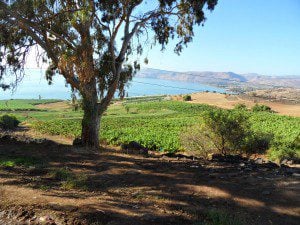Looking down the Mount of Beatitudes, where the hearers were during the Sermon on the Mount. Jesus was preaching from the “level place” below. In the background is the Sea of Galilee. [photograph by my wife Judy Armstrong, October 2014; click on the photograph for a much larger, panoramic view]
***
This is an excerpt from my book, Footsteps that Echo Forever, about my pilgrimage to Israel in October 2014.
* * * * *
Next up was the area of the Sermon on the Mount (Matthew 5-7). Here a fascinating and striking tidbit was presented by our great guide, Amer. Are you ready? Jesus didn’t preach it on top of a mountain. He preached it from halfway down the mountain, with His hearers above Him, in a “natural amphitheater.” Now that I’ve seen it with my own eyes, it makes perfect sense.
Sound projects upwards and is “caught” by the amphitheater shape (precisely why the ancient Greeks and others used that shape). Amer said that he has visited the Church of the Beatitudes at night with no one around, and could clearly hear fishermen talking down by the sea.
This is confirmed also by textual evidence in the New Testament. Jesus is described at least once as being in the water and teaching from the boat (Lk 5:3). I think it’s fairly clear that He was utilizing the same acoustic principle when He did that. The Sea of Galilee is ringed by pretty high hills all the way around.
So as the crowds who heard these sermons of Jesus grew (as they often rapidly did), they would have to spread up the hills. Jesus (knowing everything) knew that they’d be able to hear perfectly well.
Lastly, the Gospel of Luke informs us that the same sermon was preached from a “level place” (Lk 6:17; cf. KJV: “in the plain”). Atheists, in their infinite wisdom, have mocked the Bible for years, over this alleged “contradiction” (one of many bogus ones that they conjure up in their heads):
Matthew 5:1-2 Seeing the crowds, he went up on the mountain, and when he sat down his disciples came to him. [2] And he opened his mouth and taught them, . . . (cf. 8:1)
Luke 6:12-13, 17 In these days he went out to the mountain to pray; and all night he continued in prayer to God. [13] And when it was day, he called his disciples, and chose from them twelve, . . . [17] And he came down with them and stood on a level place, with a great crowd of his disciples and a great multitude of people from all Judea and Jerusalem and the seacoast of Tyre and Sidon, who came to hear him and to be healed of their diseases;
But this need not be a contradiction at all. Before I visited, I used to say that Jesus preached from a mountain that had a flat top. Now that I have been there, I can report that both things are true (but in a different manner).
A little ways up from the water and base of the hill, there is a flat area. So He preached from the plain or “level place”. But it’s also “on the mount” as well (since if one is part of the way up a mountainside, we still say he is “on the mountain”).
[Added presently: see a confirmation of this theory; and another; and another (“Acoustics aided parable” section); and another.]
The general topography of the area is confirmed, for example, by the article on “Palestine” in The Encyclopaedia Britannica of 1859 (Vol. 17, p. 182):
It is one peculiarity of the Galilean hills, as distinct from those of Ephraim and Judah, that they contain or sustain green basins of table-land just below their topmost ridges. (Stanley.)














